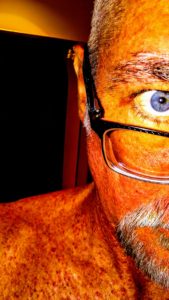 I was told twice in one day this week that I looked “bright.” I was smiling and active, keeping myself busy and directed, and I was surrounded by people who I had not seen in several months (along with a few I had never seen at all). It was the good nature of reconnecting in a friendly crowd without the threat of being lost in it, I imagine, that sparked my particularly good mood on that occasion. The description was used again on subsequent days by unrelated people, causing me to take note that, perhaps, the whites of my eyes have simply become whiter. (Insert your own Revolutionary War joke here.) Continue reading To Clear or Not to Clear
I was told twice in one day this week that I looked “bright.” I was smiling and active, keeping myself busy and directed, and I was surrounded by people who I had not seen in several months (along with a few I had never seen at all). It was the good nature of reconnecting in a friendly crowd without the threat of being lost in it, I imagine, that sparked my particularly good mood on that occasion. The description was used again on subsequent days by unrelated people, causing me to take note that, perhaps, the whites of my eyes have simply become whiter. (Insert your own Revolutionary War joke here.) Continue reading To Clear or Not to Clear
Dying, Redux
I have tried to gather a few different perspectives on what it feels like to die or go through the process of dying, including my lengthy interview with Michael March just prior to his death not long after I met him online. Below, I present a different perspective entirely from Claire Wineland, a Cystic Fibrosis patient who had been advocating about her disease for quite some time. It is a video I found on YouTube that she uploaded a while back, explaining her own experience with technically dying on a number of occasions from complication arising from her disease. Continue reading Dying, Redux
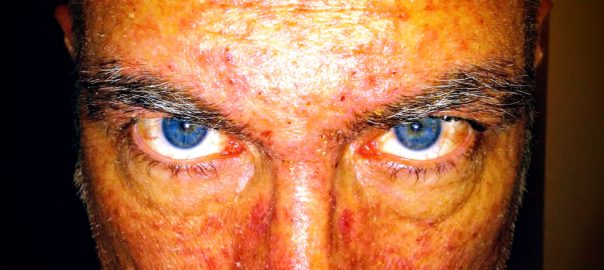
Poziotinib and Me at Month Three: Feeling Crusty (But Still Onboard)
I spent well over 45 minutes combing scabs out of my sparse hair to commemorate the end of the second week of my third month on poziotinib. Not all at once, mind you; I had the good sense not to stand hunched over the sink for more than 20 minutes at a stretch. When I was done, or at least thought I should be, I rewarded myself by sort of washing and conditioning the wiry bristles that cover much of my scalp. Such are these minor celebrations. Continue reading Poziotinib and Me at Month Three: Feeling Crusty (But Still Onboard)
August Self-Care Challenge: Making Time to Laugh
Each month lately, I have been posting an easy to achieve (but still important) self-care challenge for my readers. And for myself, really; these are all issues that I need to be working on for my own well-being. Self-care is an essential component of any patient’s treatment process and should be an essential component of life in general, whether or not you are going through physical or emotional hardships outside of the ordinary.
As classic citizens of the modern world, we all will typically ignore our own needs at some point. Even the most greedy, narcissistic, self-involved among us will sometimes fail on the basics of self-care (and sometimes directly because of those very traits). But I’m not talking to that particular demographic right now, because my readers are certainly among the more enlightened, caring, and genuine people out there. Look, I’ve said it, you’re darn awesome. But that does not mean you don’t have room to improve yourselves or the lives you lead.
One way you can do that is by making time to laugh. Continue reading August Self-Care Challenge: Making Time to Laugh
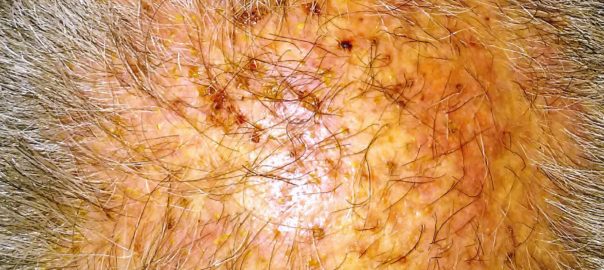
Week One: The Oozing Begins
I am now into the third month of my clinical trial for poziotinib. After the first two months, I had to take two weeks off for recovery from the rash it gave me. I am, however, glad to be back on the drug for the very simple reason that it was effectively killing the cancer within me. That is not a claim I make lightly, or, sadly, have had reason to make much at all over the past year.
When I was first put on chemotherapy back at the end of 2014, it was because there were no targeted therapies or immunotherapies available, either on the market or through clinical trials, that were likely to work for me. Chemo seemed to be the only option and, in some ways, it felt like a last-ditch effort. My tumor was considered inoperable, the metastasis had spread too far and wide, and radiation was not even being presented as an option.
While I was primed for a limited response and the possibility that I might only get a few months extension from the process, it turned out that chemo kind of worked for me. It worked well enough, in fact, that I would stay on it for over two and a half years — most of that time, simply keeping the cancer growth in stasis. There was talk of the possibility of being on that drug for five or more years at one point, but not long after the two-year mark I began to notice small changes in my scans. Very small, but changes, nonetheless. Continue reading Week One: The Oozing Begins
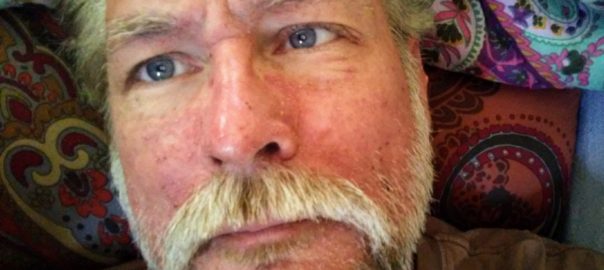
This Is Not My Body
Crouched over the kitchen sink, I surged with a repressed groan, stifling the convulsive impulse as tears broke free; I cried, uncontained, momentarily unaware why. I was so used to keeping it in, I had become disconnected from what I was actually feeling — ironic, because what I was feeling right then was disconnected.
I did not recognize my body. This vessel in which I was contained made no sense to me at all. It responded to my thoughts and commands, but it felt completely foreign. Looking down at my arms, my hands, my fingers, I recognized nothing. They could hold the dishes I was washing, turn the knob on the faucet, even scrub with the brush. But there was a clumsiness about them, an awkwardness that was hard to explain or rationalize, except to know immediately that none of that was part of my body. None of it was Me.
Such is the effect of bodily changes that occur under cancer treatment. I was experiencing a slight case of dysmorphia, that feeling of certainty that you are not in the right body. It passed, but the emotional impact lingered. Continue reading This Is Not My Body
Self-Care Challenge #4: Keeping It Together
Sometimes, self-care comes down to maintaining your own emotional health. And this is not always an easy thing to do. But if we do not work on it, keeping track of our own ups and downs, it can become too easy to get lost in a sea of anxiety and depression, carried along on waves of ennui and eventually drown out in the doldrums.
For the past seven weeks, I have been living in the midst of a clinical trial for poziotinib, a highly promising (and so far apparently quite successful) targeted cancer drug. But as with all clinical trials, there are areas of uncertainty in the treatment process, particularly with regard to side-effects and tolerance.
There have been a number of days where I have questioned whether I could keep going on with this drug — but I had vowed to see it through to my first scan at four weeks, no matter what. That scan showed a dramatic reduction in my tumor load, convincing me that another four weeks at the same dose was worth trudging through, no matter how thick and deep the gunk. But in spite of my optimism and the addition of antibiotics and antihistamines to the mix of my daily drug regimen, the primary side-effect — my full-body rash — has continued to get worse. Continue reading Self-Care Challenge #4: Keeping It Together
Recent Posts From Off the Blog
Here are a few items that you may have missed if you don’t follow me on Facebook or Twitter. See if you can find the dominant themes of the past few months!
From the Philadelphia Inquirer:
From LungCancer.net:
https://lungcancer.net/living/scans/
https://lungcancer.net/living/looking-up/
https://lungcancer.net/living/banish-survivor-from-dialogue/
https://lungcancer.net/living/awareness-breasts-to-lungs/
https://lungcancer.net/living/pets-responsibility/
https://lungcancer.net/living/relationships-bedrock-quicksand/
https://lungcancer.net/living/symptoms-vs-side-effects/
https://lungcancer.net/living/drug-free-pain-relief/
https://lungcancer.net/clinical/going-off-label/
https://lungcancer.net/living/protecting-love-worry/
https://lungcancer.net/living/body-changes/
https://lungcancer.net/living/weight-loss/
https://lungcancer.net/living/handwork-art-therapy/
https://lungcancer.net/living/prevention-risk-reduction/
https://lungcancer.net/living/bringing-friends-together/
https://lungcancer.net/living/okay-to-say/
https://lungcancer.net/living/taking-deep-breath/
https://lungcancer.net/living/needle-biopsy-experience/
https://lungcancer.net/living/biopsy-pneumothorax/
https://lungcancer.net/living/effect-relationships/
https://lungcancer.net/living/panic-attacks-reality-checks/
https://lungcancer.net/living/pain-faking-it/
https://lungcancer.net/living/opioids-cancer/
https://lungcancer.net/living/victim-blaming-narrative/
And that is everything published from April through June since the last time I published an update of my off-site material… Happy reading!
Endurance and Payoff
I have friends who are long distance runners and I have watched them struggle through their pain to achieve their goals. Although I used to train for both cross country and track way back in middle-school, I can no longer run. But I do understand a thing or two about the process. And I appreciate what it means to endure hardships in search of a personal reward.
Beginning a Clinical Trial
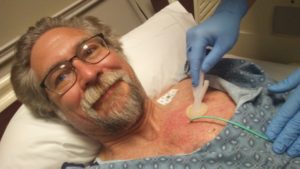
At the end of May, I began participating in a clinical trial for Poziotinib, a new targeted therapy that works on mutations in the EGFR and HER categories. Naturally, within days of my May 23rd start, I had already begun exhibiting side-effects from the new medication. The resulting rash has persisted and spread, morphing into a completely new experience for me. I thought at the time that the minor ordeal I had in preparing for the clinical trial would have been the biggest challenge of the trial itself: first I went in for a “simple” needle biopsy procedure, then I had to stay to deal with the effects when things did not go exactly according to plan. The experience even inspired an opinion piece for the Philadelphia Inquirer. But I passed over that (still relatively minor) road bump and ran headlong into the clinical trial and resulting crash back into Rashville.
Having a rash does not sound all that bad in the grand scope of things. A little salve, a dollop of willpower, and it should be easy to weather. Itching too much? Slip on some gloves or spray it with lidocaine. Rashes pass. At least it is not nausea or debilitating pain or sleeplessness. Well, at least it is not nausea. Continue reading Endurance and Payoff
Emotional Illness
Let’s get one thing straight: emotions do not cause disease. The fault of your physical illness very likely lies with something other than you. The whole notion that anything from kidney stones to cancer could be traced back to an emotional block, repressed anger, wrongs un-righted, or any other random psychological hurt from this life or a past one, is so corrupt that it should never be given credence by any rational being. Yet throngs of people with well-intentioned sounding titles like “life coach” or “healer” spread these malicious little bits of victim blaming as if they were offering salvation in a bottle of snake oil.
That said, I want it to be clear that not everyone who identifies as a healer is guilty of either victim blaming or willfully misleading those who they are trying to help. I’ve known incredibly sincere, warm, compassionate people who do their absolute best to improve the health and well-being of others through a wide swath of tools and approaches, arguably with strong results. And, frankly, many people need some form of guidance in their lives and have relied successfully on many such “coaches” to get where they need to be. I’m not condemning whole industries or forms of practice or even job titles here; this isn’t about valid occupations, but rather about those who choose to exploit the fears and insecurities of patients under the guise of offering miraculous cures through attitude adjustment. Continue reading Emotional Illness